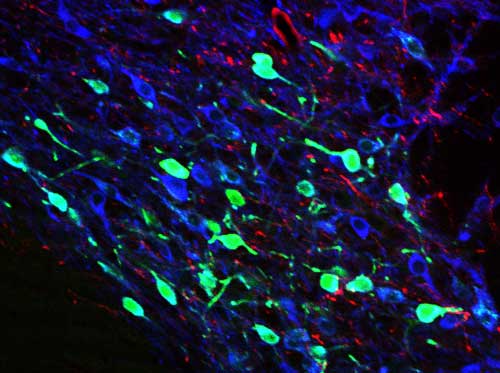

Partial view of labelled neurons in reward circuitry that starts in dorsal raphe
(pictured – ventral tegmental area)
Image courtesy Dr. Marisela Morales, NIDA IRP
Details of the role of glutamate, the brain’s excitatory chemical, in a drug reward pathway have been identified for the first time.
This discovery in rodents – published today in Nature Communications – shows that stimulation of glutamate neurons in a specific brain region (the dorsal raphe nucleus) leads to activation of dopamine-containing neurons in the brain’s reward circuit (dopamine reward system).
Dopamine is a neurotransmitter present in regions of the brain that regulate movement, emotion, motivation, and feelings of pleasure. Glutamate is a neurotransmitter whose receptors are important for neural communication, memory formation, and learning. The research was conducted at the Intramural Research Program (IRP) of the National Institute on Drug Abuse (NIDA), which is part of the National Institutes of Health.
The research focused on the dorsal raphe nucleus, which has long been a brain region of interest to drug abuse researchers, since nerve cells in this area connect to part of the dopamine reward system. Many of the pathways are rich in serotonin, a neurotransmitter linked to mood regulation.
Even though electrical stimulation of the dorsal raphe nucleus promotes reward-related behaviors, drugs that increase serotonin have low abuse potential. As a result, this region of the brain has always presented a seeming contradiction, since it is involved in drug reward but is also abundant in serotonin – a chemical not known for a role in drug reinforcement. This has led researchers to theorize that another neurotransmitter may be responsible for the role that the dorsal raphe nucleus plays in reward.
“We now have strong evidence of a reward pathway that starts with stimulation of glutamate neurons in the dorsal raphe nucleus and ends in activation of the dopamine reward system,” said NIDA Director Dr. Nora D. Volkow. “These findings help us better understand the brain’s reward circuitry and opens up new avenues of research into the neurobiology of drug addiction.”
In these rodent models, researchers used special tracers and labelling compounds to confirm that this circuit in the reward pathway begins with glutamate cells in the dorsal raphe nucleus that connect to dopamine cells in the ventral tegmental area, which in turn travel to the nucleus accumbens, a brain structure linked to motivation, pleasure, and reward.
After verifying the pathway, investigators used optogenetic techniques (using light to control activity of modified cells) and chemical blockers to confirm that glutamate, not serotonin, is responsible for activating this reward circuitry.
“This glutamatergic pathway is the first fully characterized link between electrically stimulated reward circuitry and the dopamine system on which it depends,” said Dr. Marisela Morales, NIDA IRP scientist and senior author on the paper. “The discovery of this specific brain pathway opens new avenues to examine its participation in a variety of disorders related to motivation.”
The paper by Qi et al. can be found at www.nature.com/ncomms/index.html . For similar research currently being conducted by NIDA IRP in this area, go to: http://irp.drugabuse.gov/cnrb.php#Anchor-Anatomy-48213 .
Contact:
NIDA Press Office
301-443-6245
media@nida.nih.gov
About the National Institute on Drug Abuse (NIDA): NIDA is a component of the National Institutes of Health, U.S. Department of Health and Human Services. NIDA supports most of the world's research on the health aspects of drug abuse and addiction. The Institute carries out a large variety of programs to inform policy and improve practice. Fact sheets on the health effects of drugs of abuse and information on NIDA research and other activities can be found on the NIDA home page at www.drugabuse.gov. To order publications in English or Spanish, call NIDA's new DrugPubs research dissemination center at 1-877-NIDA-NIH or 240-645-0228 (TDD) or fax or email requests to 240-645-0227 or drugpubs@nida.nih.gov. Online ordering is available at drugpubs.drugabuse.gov. NIDA's media guide can be found at www.drugabuse.gov/publications/media-guide, and its new easy-to-read website can be found at www.easyread.drugabuse.gov .
About the National Institutes of Health (NIH): NIH, the nation's medical research agency, includes 27 Institutes and Centers and is a component of the U.S. Department of Health and Human Services. NIH is the primary federal agency conducting and supporting basic, clinical, and translational medical research, and is investigating the causes, treatments, and cures for both common and rare diseases. For more information about NIH and its programs, visit www.nih.gov .
NIH. . .Turning Discovery Into Health®












